Toad is the common name for specific types of frogs that have dry, warty skin and short legs.
Encouraging toads to stay in your garden helps to balance your garden’s ecosystem and means you don’t need to use pesticides as they eat many pests.
Some of the most common wild Toads include the American, Cane and Fowler’s. Every toad is a carnivore and needs a balanced diet.
If you are a first-time owner or looking to attract some to your garden then read on to learn what to feed them…
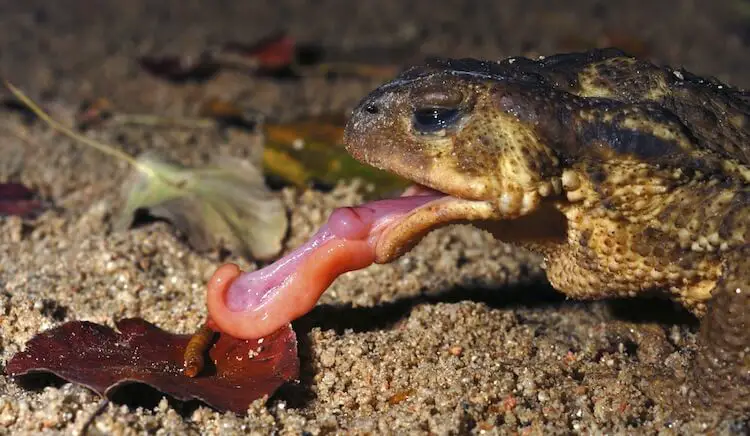
What Do Toads Eat?
Wild Toads are carnivores and eat a large variety of foods. They feed on insects, rodents, reptiles and amphibians! They prefer live prey and will eat almost anything in their reach including:
- Crickets
- Flies
- Mealworms, Wax worms and Super worms
- Spiders
- Grubs
- Mice, rats and rodents
- Locusts
- Other toads and frogs
Toads eat different types of food throughout their lifetime.
As they grow from tadpoles to juveniles and then to adults their feeding pattern and diet will change.
Feeding Tadpoles
Tadpoles are the immature forms of frogs. This is also the only stage of their life where they are not carnivores.
They are fully aquatic and have not fully developed air-breathing lungs yet. Because of this they are confined to the pond or lake they are born in.
After hatching they eat what is left of the yolk in their egg sack. Once that is eaten tadpoles will feed off aquatic vegetation (i.e. algae and other plant matter).
Some species are cannibalistic and will eat other tadpoles.
Cannibalistic tadpoles are rare and this only happens when aquatic vegetation is scarce. As long as they have plenty of vegetation this should not be an issue.
Feeding Juvenile Toads
Tadpoles become juvenile toads after their tails disappear and their legs form. At this part of their lifecycle juvenile will eat smaller insects because they do not chew their food.
They should be fed four to six leaf rollers, grain moths, small earthworms or mealworms daily.
Juvenile toads swallow food whole so will choke if they eat prey that is too large (e.g. rodents).
As they grow larger their appetite continues to increase and the range of foods they will eat grows.
Feeding Adult Toads
Wild adult toads are not very picky eaters. They will eat anything that they can swallow. They should be fed six crickets, wax worms or super worms every two days.
The main limitation of their diet is their size and what they can swallow.
Larger toads tend to have a broader range of foods to eat.
Because of their all-encompassing diet they will eat both beneficial and harmful garden insects. Generally the overall impact is positive for gardens.
What Do Toads Eat In The Wild?
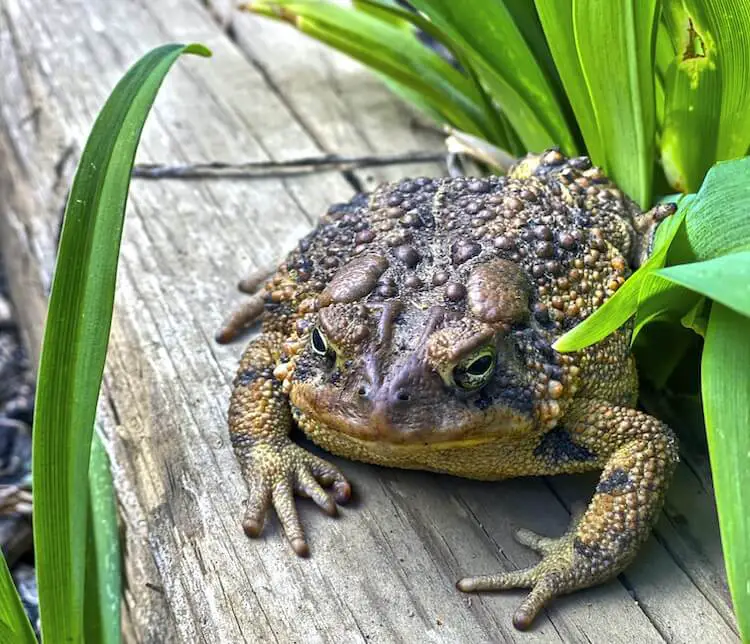
Toads eat a large variety of live prey in the wild. Like us they need a balanced diet so generally eat four to six crickets, worms or spiders every few days.
Generally the larger the toad the longer the list of potential foods. Larger species such as the cane toad eat rodents.
Each species of toad is different but they generally have the same dietary needs.
Adults will eat:
- Bugs
- Centipedes
- Flies
- Weevils
- Crickets
- Grasshoppers
- Mealworms
- Locusts
- Snails
- Slugs
- Aquatic animals
Adult toads have a much larger range of food options because they are less at risk of choking. Juveniles are relatively small and can eat ants, flies, or pinhead crickets.
In your garden toads eat whenever they can find prey. In the wild they do not know when the next meal will come. They also have limited appetite control and so will continue to eat until it is all gone.
Wild species only eat live prey because dead insects and animals could carry a host of diseases.
Most garden toads eat at night because it is the best time for catching insects. Insects are attracted to light and toads are easily able to hunt them for two main reasons:
- The dark night allows them to camouflage and remain hidden.
- They have specialized eyesight for lower light.
Toads sometimes hunt during the daytime, but only after it rains.
After rainfall your garden will be cloudy, cool, and moist. Like most amphibians, toads enjoy moist climates. They will use this as an opportunity for daytime hunting as rain can draw earthworms out of the soil.
Each species of toad has its own hunting style.
For toads with long tongues such as the black, western and Natterjack they flick their tongues to snag their prey. They tend to crawl or hop around in order to hunt.
Species without long tongues do not have teeth and so cannot chew their food. They swallow it whole instead.
What Do Pet Toads Eat?
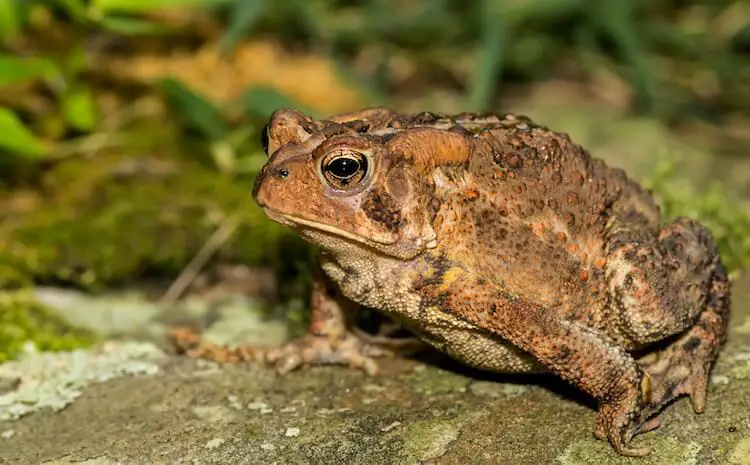
People who keep pet toads tend to feed them crickets, or worms (e.g. mealworms or super worms) as this prey is readily available. Some will catch wild prey such as mice or insects but this is not recommended because of the risk of bringing in diseases or sick animals.
If you are keeping a pet toad, make sure you research the specific species to ensure you are not feeding them food they do not usually eat.
They should still be fed a variety of prey they naturally hunt in the wild.
Make sure any prey or insects you feed are alive. Feeding live insects will encourage them to hunt.
If your pet is large enough to eat rodents then you can feed it but make sure to monitor them. Rodents can scratch or bite your toad – especially their eyes.
Pet toads are different from wild ones and recognize routine. They need consistent husbandry and feeding times.
You should feed toads at the same time every day to help them establish a constant feeding routine.
Because they are nocturnal the best time to feed is around 21:00. using the schedule below:
| Day | Food | Supplement(s) | |
|---|---|---|---|
| Juvenile | Adult | ||
| 1 | 4x Leaf rollers | 6x Crickets | Calcium (both) |
| 2 | 4x Pinhead crickets | Nothing | Calcium (juvenile) |
| 3 | 4x Grain moths | 6x Wax worms | Calcium and Multivitamins (both) |
| 4 | 4x Small earthworms | Nothing | Calcium (juvenile) |
| 5 | 6x Mealworms | Nothing | Calcium (juvenile) |
| 6 | 4x Ant | 6x Super worms | Calcium and Multivitamins (both) |
| 7 | 4x Fruit flies | Nothing | Calcium (juvenile) |
In captivity they eat less frequently than in the wild. They prefer live food and will eat everything within 15 minutes. 15 minutes after feeding remove any leftover food to prevent it from rotting or from overfeeding your toad.
If you are feeding insects from a pet store then make sure to gut load them first.
Gut loading is the process of feeding fruits and vegetables to crickets or worms before you feed them. This improves the range of nutrients your toad eats.
Pet store crickets and worms normally are lower in nutritional value when compared with those found in the wild. Gut loading is the best way to provide them with nutrients.
Another deficiency found in for pet toads is UVB. Toads that live inside do not get the same amount of sunlight exposure and nutrients as wild animals.
Specifically they lack UVB light that helps them absorb calcium and other vitamins
To help them get all of the nutrients they need you should dust any food with calcium and vitamin supplements. Calcium should be added every meal and multi-vitamins should be given once a week.
What Do Juvenile Toads Eat?
Baby toads should be fed every day. They typically eat pinhead crickets, small earthworms or fruit flies. You should feed four to six items from the food list below every day:
- Small crickets
- Pinhead crickets
- Leaf rollers
- Grain moths
- Small earthworms
- Mealworms
- Aphids
- Ant
- Fruit flies
The trickiest part about feeding juveniles is making sure their food is the correct size. Toads do not chew their food so it is very easy for them to choke on meals.
Make sure the food you feed is no bigger than the width of their head.
If small crickets are too large then feed fruit flies or gnats. Other good foods include pinhead crickets, mini wax worms or super worms.
They should all be gut loaded with many different vegetables, including kale, carrots, or spinach.
Common Feeding Mistakes
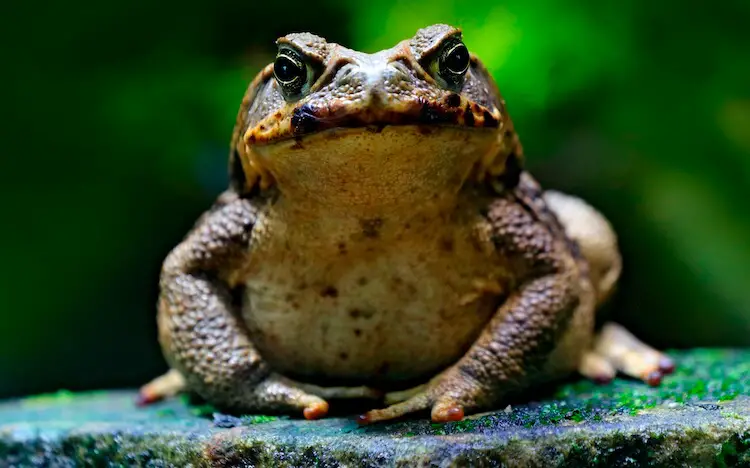
There are three common feeding mistakes that keepers can make when feeding toads:
- Feeding wild caught insects.
- Feeding insects that are too big.
- Feeding dead prey.
- Feeding the wrong food.
If you feed wild caught insects or prey without properly checking if they are healthy to eat you can cause severe parasitic infections.
These infections are typically caused by giving a toad prey that has an illness.
It must be treated by a vet.
The best way to avoid this is to only feed toads store purchased food.
Overfeeding and underfeeding is common among captive toads. Vets can inspect fat deposits and tell you if they are overweight. Obesity can lead to a shortened lifespan if not treated.
Finally, not feeding enough nutrients can result in vitamin or calcium deficiencies.
This is characterized by lethargy and swelling in certain areas of the body. This is easily treated with regular supplements and a UVB light in their enclosure.
What Can’t Toads Eat?
Toads will eat anything given to them. However, that does not mean every type of food is good for them. The foods below are dangerous for toads and should not be fed:
- Rice
- Bread
- Seasoned meat
- Salt or sugar
- Processed food
- Pesticides
- Expired food
Toads are carnivores and prefer to eat live prey or meat. They do not eat previously killed prey or dead meat.
Generally they will eat anything that fits in their mouth.
It is safe for them to occasionally eat fruits and vegetables but they might not be happy doing so.
You should not feed a toad any foods that humans eat such as leftovers, processed food, salt or sugar. Salt and other seasonings can hurt their gut and dehydrate them.
Only feed toads food they would hunt in the wild, supplements and vitamins.
Make sure you do not feed expired or old vitamins. These supplements usually expire after six months.
Do Toads Need Water?
Yes. Toads are amphibians so it is important for them to have a large dish of water. Interestingly they do not drink water but instead soak it through the skin on their bellies.
Their water bowl should be cleaned and dechlorinated every few days to prevent them from soaking up unhealthy chemicals.
Make sure that their water bowl is a good depth for them to soak in, but that they can always climb out unassisted. Although adults live in aquatic environments their lungs develop to breathe oxygen from the air (instead of from water) and can therefore drown.
The humidity generated from a water bowl helps them to stay hydrated too. You can also use a misting system. Toads need an enclosure with high moisture.
Make sure that whatever enclosure you purchase has a tight-fitting lid as they are prone to escaping.
Summary
Toads will eat most insects and prey they find in your garden. It is safe to feed toads crickets, flies, spiders and worms.
Tadpoles and juveniles eat every day compared to adults who eat three times a week.
They should not be fed seasoned meat, salt, sugar, processed food or pesticides.
If you are keeping a pet toad you should stick to a constant feeding schedule and dust their food with calcium and vitamin supplements. Also make sure that you provide a water dish so they can soak and stay hydrated!
If you follow this article you are sure to have a happy and healthy toad – either as a pet or in your garden.
Have fun with their diet and let us know what you feed your pet in the comments.

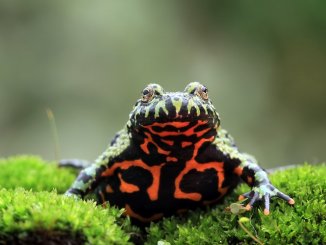
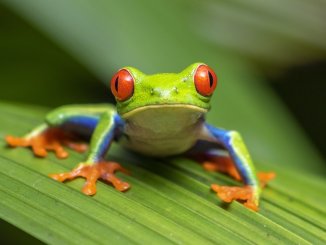
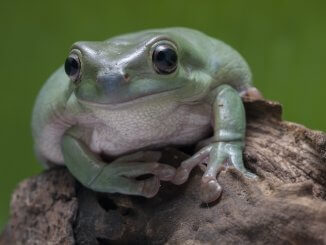

Can an american toad owner who feeds them crickets with calcium and vitamins catch any disease from either? I order my crickets from a well know company.